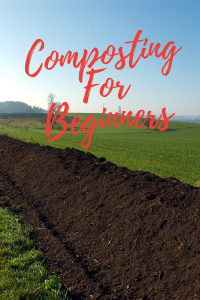How To Compost For Beginners
When we finish making a salad, or making a fruit salad or peel a banana or orange..the question is what do we do with the extra fruit and veggie scraps? Do we toss them in the garbage or down the drain? Well, I used to think we do either of these solutions until I decided to start composting! Yes, composting!
What is composting you ask?
Let me break it down for you! In general, composting is the breaking down of organic material. According to Wikipedia, “Compost is organic matter that has been decomposed in a process called composting. This process recycles various organic materials otherwise regarded as waste products and produces a soil conditioner. Compost is rich in nutrients. “ Wikipedia
By collecting certain food scrap items and other items we might normally toss out…or normally throw away, we can turn them into a soil prepping machine for our garden! If we are lucky enough to have some soft-scape areas in our backyards or side yard etc.. we may have an opportunity to have a blank soil area or to create one. But not all soil is the same and sometimes it needs extra nutrients in order to be rich in nutrients to grow your plant veggies and fruit! This is where composting comes in!
The benefits of composting
One of the best benefits to composting is to eliminate household waste. We can reduce waste by taking the time to collect scraps, eggshells and more and re-purpose them to add nutrients to our soil in our gardens and in turn ensure healthy growth and propagation of herbs, fruits and veggies for years to come.
Another benefit of composting is that we can add “energy” back into the soil and re-energize the soil history to help vegetables grow with more ability to fight diseases and grow stronger in the environment. Compost and the microorganisms that grow from it really work together to help plants absorb nutrients.
What do you need to compost?
You need four main ingredients to complete the process.. You need
- organic material,
- water,
- soil
- air.
In order to put together the organic material you need to collect a few items to begin the process.
You can start with scraps and pieces of what we can think of as the GREEN part of the compost. You can collect scraps of fruit waste, vegetable scraps or vegetable waste, egg shells, used coffee grounds, grass clippings, etc.
You will need to collect these “green” portions of the compost and also eventually you will need some BROWN parts of the compost. The “brown” portions include things like dry leaves, corn cobs, pine needles, sawdust, etc. The basic idea here is that once you have collected the GREEN materials and the BROWN materials, you can “layer” the Brown on top of the Green materials and these work together to create a magical compost pile which will be used as the basis of a nutrient making machine.
The general rule is 3 parts “Brown” waste to 1 part “Green” waste in your pile. If you are making a free-standing pile, just make sure its away from neighbors, family members, pets and in kind of a “private” spot for itself to germinate.
You let this pile “germinate’ together for a while. Because the compost pile needs air and water also, besides soil and the waste matter.. You will need to stir the pile every couple weeks.
When the compost pile has “done” its job, you will end up with a soil looking pile and would actually smell like soil not like the compost ingredients. So look out for that!
Compost can really help your garden. It creates great soil for growing vegetables and more. The chemistry of the soil is such that it has a plethora of nutrients it needs to assist plants in growing healthily and the best they can.
For a vegetable garden, you will add the composted soil into the potting soil area for your vegetable garden. Just mixing it in gently and this adds some nutrient soil to the garden for your veggies.
For bulb garden, go ahead and mix some into the soil beneath the bulb for extra help growing. Compost soil can also be used for the rest of your yard as well. You can add it to your grass and bushes and it helps all the green living things in your yard and gives them a boost.
Each plant or tree or bulb or garden area has a specific amount of composted soil you would need to add.
Composting is such a good way to re-use waste from our daily lives that we would otherwise just toss into the garbage.
You can make this a family project for everyone in your home. The idea that we can take things that are waste and put them to a re-purposing effort is such a great thought and gives promise to giving new energy to old things!
If we can all take some time to look into these types of re-use we can help find ways to help the earth all around. Compost helps the plants and vegetables, fruits and more to grow as best they can!

